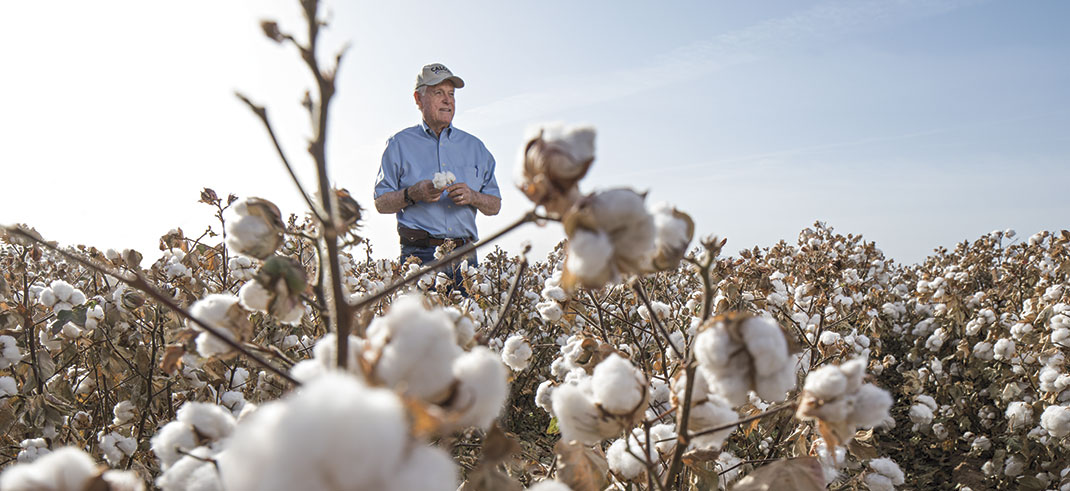“We’ve got producers that are not experiencing one of the most profitable crops due to a couple of things: ever-increasing production costs and the cotton price."
When it’s all said and done, the 2017 cotton crop is likely to be the third or fourth largest crop ever produced on the Texas High Plains but not likely the most profitable for many growers, says Steve Verett, Plains Cotton Growers executive vice president.
According to the December USDA NASS report, the High Plains is expected to produce 5, 570,000 million bales of cotton. “We’ve got producers that are not experiencing one of the most profitable crops due to a couple of things: ever-increasing production costs and the cotton price. Cotton prices are really at pretty good levels right now. But when you throw in the quality of the crop, and a lot of the quality is not what we’d like it to be, especially from a micronaire perspective, we’re seeing a reduction in normal quality levels of anywhere from 5 to 6 cents, so it’s pretty well negating any price increase we’ve seen this year,” explains Verett.
To top that, because cottonseed competes in the oilseed market with other commodities such as soybeans and soybean prices are down significantly, the cottonseed price is down, also reducing overall revenue. “So all of these things added together, in spite of a better than average crop, it’s going to be very tight this year from a profitability standpoint,” explains Verett.
The big challenge for producers, over the last four to five years, has been in weed control and the increased cost that comes with it. “Whether it’s from increased herbicide cost or adding different herbicides to try to offset the lack of control, especially for pigweed or Palmer amaranth, or from hoeing costs or manual weeding costs to take care of weed control, we’ve seen a $40-$50 an acre increase in weed control costs,” says Verett.
One addition that provided another tool in the toolbox for producers last season, was the approval of the herbicides for both the Xtend cotton system and the Enlist system, the 2,4D and the dicamba. “But those come at a cost as well. There’s an additional cost on the tech fee side,” says Verett. “It did at least provide another tool to manage that weed. But as far as reducing cost, I wouldn’t say it’s reduced the cost, I’d say it's just provided another way to do it.”
Finishing a not-so-profitable year coupled with a lack of measurable precipitation makes beginning another season challenging for growers. “I’ve been visiting with folks, and I think that there’s always a concern, when we come off of a year that’s been less than spectacular, there’s going to be a lot of folks not making all of the ends meet, not being able to repay all of their loans and meet all of their financial obligations given this crop, especially with what happened with the quality and the ultimate resulting price,” says Verett. “And we know that we need to get some winter moisture in order to get the soil profile where it needs to be for this spring. It’s not that there’s still not time, but certainly, that’s another thing that’s nagging at people’s minds right now in trying to make plans on how they need to plan based on what the weather may do.”
Farm Bill
With one year remaining in the 2014 farm bill, efforts continue to be made towards trying to get cotton back in Title I before the expiration. “We have the legislation in place, as recently as two weeks ago. Before the Congress left the House they put in their disaster supplemental bill to cover a lot of the hurricane damage. There was a provision in there to put cotton back in the farm bill for 2018 crop,” Verett explains. “It got over to the Senate and the Senate failed to take up the supplemental bill. We’re hopeful that they’ll do that in January when they come back because we can’t wait another year. Cotton needs to be back in the Farm bill now.
“My greatest fear, despite the best attempts and intentions of House Ag Committee Chairman Mike Conaway and Senate Ag Committee Chairman Pat Roberts to make sure we get a farm bill done in 2018 so it’s in place for the 2019 crop, that that might not happen and we may end up with an extension. And we certainly couldn’t wait another year. We’re hopeful that we will get this done in January and cotton will be back in the farm bill in 2018, then we will be negotiating from a lot better strength as we start debating the Farm bill this spring for a new 5-year farm bill. That’s what we’re hopeful for at this point.”
Tax Reform
Generally speaking, Verett says taxes and how they are structured can affect people differently. “But from everything that we’ve looked at in this tax bill, it’s hard to make the case that practically all farming operations aren’t going to see some tax decrease. Overall, that seems to be the case. I think it’s going to be beneficial.”
The upside
While the 2017 cotton crop may not have produced the quality for which many producers were hoping, for those who did have quality cotton, the price was favorable. “If you had quality cotton in 2017, cotton’s been selling for 72 cents to 82 cents. It appears that demand is coming back, especially for folks in our area.”
As growers head into 2018, Verett says the challenging part is what ultimately happens with the farm bill and the rainfall, as it’s been 60 days since significant moisture has been received. “I’m hopeful this can be a year that prices will meet the cost of production and provide a bright side for folks looking into 2018.”
Πηγή: Southwest Farmpress

